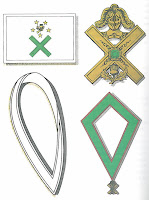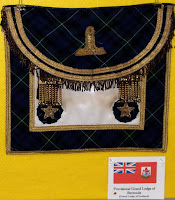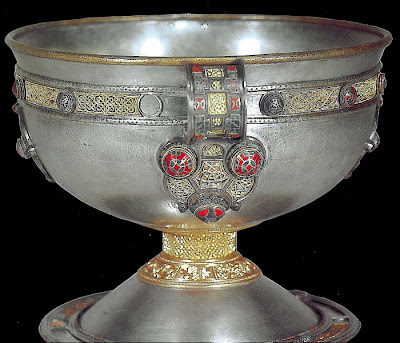 DATE: November 30th, 2008 Feast of Saint Andrew
DATE: November 30th, 2008 Feast of Saint Andrew
WEATHER: A most glittering starlight sky
OUTLOOK: No sufferingOn this day in 1736, the Grand Lodge of Scotland was formed when about a third of the approximately 100 known lodges sent representatives to Edinburgh to settle the matter. Despite being the native land of the
earliest known Masonic lodges, Scotland was not the first to form a national body. The 30th of November was selected because it is the Feast Day of St. Andrew, who is the patron saint of Scotland and of Scottish Freemasonry. It is his
Feast Day because on this date in 60 C.E., during the reign of
Nero, he was martyred.
There was that
Hellenic period in Jewish history when Jews had Greek names, and the name Andrew indeed derives from the Greek word for “manly.” (Somehow,
“Andrew Palmer Hall” just sounds bland.) Considering he was one of the 12 chosen to be Apostles, it is odd that Scripture doesn’t offer much information on him. What little I know is found
here.
“St. Andrew is said to have been crucified on an X-shaped cross, although there is no historical evidence to support this claim,” writes Rex Hutchens in his book
A Bridge to Light. “The cross bearing his name appears on the Scottish flag. He is said to have appeared to Hungus, King of the
Picts in the ninth century, promising him victory in a battle with the English
King Athelstan who sought to conquer Scotland. In the sky that night St. Andrew placed the shape of the cross on which he was crucified as a token of this promise or covenant. The Picts defeated
Athelstan and thereby maintained their liberty, for a while.”
Scotland figures significantly in the history of American Freemasonry. “It has been established that the first Freemason known to have been in America was
John Skene,” says
Coil’s Masonic Encyclopedia, “whose name appears on the roll of Lodge of Aberdeen and who settled at Burlington, New Jersey in 1682.” (The
lodge in Aberdeen itself can be traced to the year 1483, according to this same reference book.) Chartered Nov. 30, 1756, St. Andrew’s Lodge in Boston would distinguish itself several times during the colonial era. In 1764 it became the first Masonic lodge anywhere to possess its own hall upon purchasing the
Green Dragon Tavern. On Dec. 16, 1773, this lodge became linked, accurately or otherwise, to the
Boston Tea Party when some of its members – enough to prevent the lodge from holding its meeting scheduled for that evening – involved themselves in the Tea Party.
St. Andrew’s Masons are found around the world. In Scandinavia, where the
Swedish Rite continues Scottish traditions (incidentally, the GL of Scotland warranted St. Magnus Lodge No. 199 at
Gothenburg in 1780), there are St. John’s lodges that confer the three Craft degrees, from which the deserving may be allowed to progress to the St. Andrew’s lodges, which work three subsequent degrees.
 Aprons of the V° and VI° of St. Andrew's Masonry in Norway. (Courtesy of the Museum of Masonic Culture, Lincoln Park, New Jersey)
Aprons of the V° and VI° of St. Andrew's Masonry in Norway. (Courtesy of the Museum of Masonic Culture, Lincoln Park, New Jersey)Today, American Masons must look to the Scottish Rite for remnants of St. Andrew’s Masonry or Scotch Masonry. It is the 29° in that system of degrees that still holds the title Knight of St. Andrew. (Plus, there is a
fraternity of this name within the Scottish Rite.) There being two Scottish Rite jurisdictions in the mainstream of the fraternity, it should be noted that more than one version of this degree is extant, and that both versions have undergone many changes over the years. The form of this degree circa 1804 is of interest to students of the history of
“High Degrees.” In it, the Grand Master of Ceremonies explains to the candidate the differences between the three degrees of St. John’s lodges and this degree:
An Elder Scottish Master is a high Priestly Order, my Brother, and highly different from the Blue Master. A Master of the three lower degrees, wherein until now you was only taught to venerate the Godhead, under the name of the Most Great, Most Wise and Almighty Architect of the Universe. But an Elder Scottish Master must pay a more deep and feeling veneration to the Almighty God. That due veneration we are taught by the teacher and declarer of our Holy Order, when he says “The true worshippers will worship him in spirit and in truth.” The first veneration is common to all men and Brethren, as directed by common sense, but the latter belongs to those who dedicate their hearts for the dwelling of the Most High and Merciful God, the Grand Architect of the Universe.
The candidate then is informed that his current working knowledge of the use of the Square and Compasses, which is “only” for “mathematical geometry,” merely hints at their purpose in the Scottish work. He then receives the Signs, Tokens and Words of the degree. “The first part of the Grand Scottish Sign alludes to the Priests in the Temple, who always put their hands to their foreheads… as if to keep off the rays, whenever they gave the benediction.” Then comes a lesson in alchemical matters, followed by the knighting.
(Source: Ordo Ab Chao
. Illustration courtesy of Scottish Rite Research Society.)This degree today, as worked in the A&ASR Southern Jurisdiction, instructs in nine virtues, presented in three groupings of three. Hutchens writes: “Humility, Patience and Self-Denial are the three essential qualities of a Knight of St. Andrew of Scotland.” Charity, Generosity and Clemency must be enlisted in the defense of “all orphans, maidens, and widows of good family, and wherever they heard of murderers, robbers, or masterful thieves who oppressed the people, to bring them to the laws, to the best of their power.” Virtue, Truth and Honor “protects us when we are unarmed, and is an armor that we cannot lose, unless we be false to ourselves…. Nor is there wisdom without virtue, but only a cunning way of procuring our own undoing.”
(This mention of armor may be a link to the alchemical symbolism of the 1804 ritual, which speaks pointedly of seven planets and seven metals. I’ll have to read up on that.)
In his encyclopedic
Scottish Rite Ritual: Monitor and Guide, Ill. Art de Hoyos describes the degree as one “intended to inculcate equality, representing the poor knight equal to the monarch…. The beautiful Masonic doctrine of Toleration is exemplified in this.”
 The apron of the 29°
The apron of the 29°
depicts
the St. Andrew's cross,
thistle
and stars.
(Courtesy of the Museum
of Masonic Culture,
Lincoln Park,
New Jersey.)One virtue that first comes to the minds of many Masons when asked to define Freemasonry is Toleration, and in fact that is the key purpose of the 29° here in the Northern Masonic Jurisdiction of the AASR. In the mid 19th century, the NMJ’s ritual of this degree was similar in philosophy to the ritual the Southern Jurisdiction uses today. The Knight of St. Andrew had the missions of rebuilding churches destroyed in the Holy Land by the Saracens; of protecting pilgrims to the Holy Land; and of performing other duties of knighthood. In the years following, it underwent many changes, and was set in the court of a Turkish sultan.
As the historical notes prefacing the ritual say:
The Knights of Saint Andrew appear before him loaded with chains. The Sultan discusses ransom for the captives. He asks concerning the Order of Knighthood and requests an invitation. He is at first refused until Knights learn from the Koran that the essentials of belief are the same. The Sultan and two Emirs are received into the Order. Ransom is paid by the Sultan and Emirs. A lengthy lecture on “Toleration” concludes the Degree.In 1896 the degree took the form the NMJ knows today, although other rewritings would arise until 2003. It takes place in 1396 at Patras (ancient Patrae), in
Achaia, Western Greece, and inside the Cathedral of St. Andrew, temporary military headquarters of Sultan
Bayazid I.
“Masonic equality is not an artificial leveling of wealth or outward conditions,” says the Prologue of the degree. “It is the true equality which should exist between men of virtue and high ideals, regardless of such conditions. In the code of chivalry, the poorest Knight and the greatest King were equal as Knights. Masonic toleration is respect for the opinions of others. No one man, no one church, no one religion has a monopoly on truth. We should be true and faithful to our own opinions, and we should extend to the opinions of others the same respect we demand for our own.”
S.M.I.B.
▲▼ ▲▼ ▲▼ ▲▼ ▲▼ ▲▼ ▲▼ ▲▼ ▲▼ ▲▼ ▲▼ ▲▼ ▲▼ ▲▼
 Regalia of the 29°. (Courtesy Scottish Rite Research Society)
Regalia of the 29°. (Courtesy Scottish Rite Research Society)“The Cross of St. Andrew is an ancient symbol, far older than Christianity,” writes Ill. Jim Tresner, author of
Vested in Glory. “It is formed in the heavens by the point at which the celestial equator crosses the plane of the eliptic. Seeming to have symbolized the idea of change from very early times, it appears on ancient statues of the
Mithraic deity Kronos, the lion-headed, winged human figure often shown standing on a globe marked with that cross, probably suggesting change as a function of time.”
The thistle is the national emblem of Scotland.
“The Danes invaded Scotland and stealthily surrounded Staines Castle,” according to
A Bridge to Light. “They took off their shoes to wade the moat, only to find it dry and filled with thistles. The resultant yells and curses roused the garrison, and the Danes were soundly defeated.”
 Regalia of the 29°. (Courtesy Scottish Rite Research Society)
Regalia of the 29°. (Courtesy Scottish Rite Research Society)The aprons shown below are among the many Scottish Masonic aprons on display at the Museum of Masonic Culture, located at the Valley of Northern New Jersey.
 Grand Lodge of Scotland apron highlighting the MacQueen tartan.
Grand Lodge of Scotland apron highlighting the MacQueen tartan. The apron of the Grand Lodge of Scotland's Provincial GL of Bermuda, featuring the Black Watch tartan.
The apron of the Grand Lodge of Scotland's Provincial GL of Bermuda, featuring the Black Watch tartan. An apron from Scotland's District Grand Lodge of South Africa.
An apron from Scotland's District Grand Lodge of South Africa.
This apron is from Scotland's
District Grand Lodge of the Middle East, which includes Lebanon, which is also ground zero in the
current feud between the grand lodges of New York and Washington, DC.
 While normal people devote time and energy in December planning things to do on Christmas or Hanukkah or New Year’s Eve, there exists a subculture of people like myself who plan for St. John’s Day.
While normal people devote time and energy in December planning things to do on Christmas or Hanukkah or New Year’s Eve, there exists a subculture of people like myself who plan for St. John’s Day.









































































































